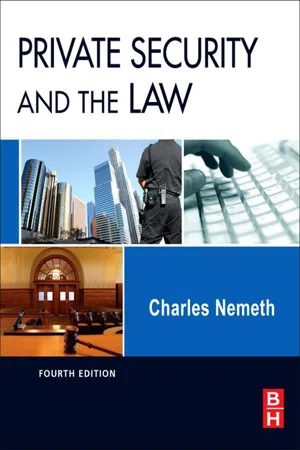
Private Security and the Law
Charles Nemeth
- 640 páginas
- English
- ePUB (apto para móviles)
- Disponible en iOS y Android
Private Security and the Law
Charles Nemeth
Información del libro
Private Security and the Law, Fourth Edition, is a unique resource that provides a comprehensive analysis of practices in the security industry as they relate to law, regulation, licensure, and constitutional questions of case and statutory authority. It is an authoritative, scholarly treatise that serves as a solid introduction for students regarding the legal and ethical standards that shape the industry.
The book takes you step-by-step through the analysis of case law as it applies to situations commonly faced by security practitioners. It describes the legal requirements faced by security firms and emphasizes the liability problems common to security operations, including negligence and tortious liability, civil actions frequently litigated, and strategies to avoid legal actions that affect business efficiency. It also examines the constitutional and due-process dimensions of private security both domestically and internationally, including recent cases and trends that are likely to intensify in the future. New features of this edition include: a chapter on the legal implications of private contractors operating in war zones like Afghanistan; updated coverage of statutory authority, as well as state and federal processes of oversight and licensure; and special analysis of public-private cooperative relationships in law enforcement. A historical background helps readers understand the present by seeing the full context of recent developments.
This book will appeal to: students in physical security, security management, and criminal justice programs in traditional and for-profit schools; security professionals; and those working in law enforcement.
- Authoritative, scholarly treatise sheds light on this increasingly important area of the law
- Historical background helps readers understand the present by seeing the full context of recent developments
- National scope provides crucial parameters to security practitioners throughout the US
- NEW TO THIS EDITION! A chapter on the legal implications of private contractors operating in war zones like Afghanistan, updated coverage of statutory authority, updated coverage of state and federal processes of oversight and licensure, special analysis of public-private cooperative relationships in law enforcement
Preguntas frecuentes
Información
1
Historical Foundations of Private Security
Chapter outline
Introduction: The Concepts of Self-Help and Self-Protection
Historical Foundations
The Middle Ages
Índice
- Cover Image
- Table of Contents
- Title
- Copyright
- Dedication
- Acknowledgments
- 1. Historical Foundations of Private Security
- 2. Regulation, Licensing, Education, and Training
- 3. The Law of Arrest, Search, and Seizure
- 4. Civil Liability of Security Personnel
- 5. Criminal Liability of Security Personnel
- 6. The Enforcement of Laws and the Collection, Preservation, and Interpretation of Evidence
- 7. Public and Private Law Enforcement
- 8. Selected Case Readings
- Appendix 1
- Appendix 2
- Appendix 3
- Appendix 4
- Index